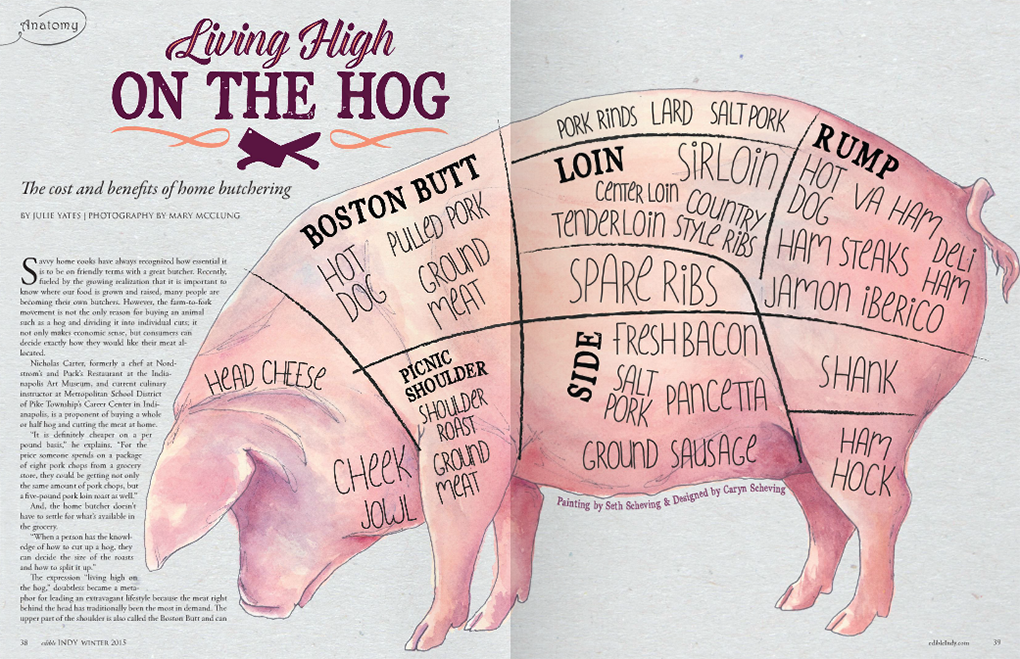Living High on the Hog
Savvy home cooks have always recognized how essential it is to be on friendly terms with a great butcher. Recently, fueled by the growing realization that it is important to know where our food is grown and raised, many people are becoming their own butchers. However, the farm-to-fork movement is not the only reason for buying an animal such as a hog and dividing it into individual cuts; it not only makes economic sense, but consumers can decide exactly how they would like their meat allocated.
Nicholas Carter, formerly a chef at Nordstrom’s and Puck’s Restaurant at the Indianapolis Art Museum, and current culinary instructor at Metropolitan School District of Pike Township’s Career Center in Indi-anapolis, is a proponent of buying a whole or half hog and cutting the meat at home.
“It is definitely cheaper on a per pound basis,” he explains. “For the price someone spends on a package of eight pork chops from a grocery store, they could be getting not only the same amount of pork chops, but a five-pound pork loin roast as well.”
And, the home butcher doesn’t have to settle for what’s available in the grocery.
“When a person has the knowledge of how to cut up a hog, they can decide the size of the roasts and how to split it up.”
The expression “living high on the hog,” doubtless became a metaphor for leading an extravagant lifestyle because the meat right behind the head has traditionally been the most in demand. The upper part of the shoulder is also called the Boston Butt and can be sliced as a roast or into shoulder steaks. When cooked low and slow either in an oven or in a CrockPot, this makes wonderful pulled pork or barbecue. Immedi-ately behind the shoulder along the upper back is the loin. This is the leanest area and yields loin roasts, tenderloins or pork chops. These cuts are best grilled or baked in an oven.
The middle of the pig is the location for products that come to mind when people think of pork: ribs, ba-con and ham. In the front is the picnic shoulder, which can be roasted or ground to make sausage. The central middle is where spare ribs and fresh bacon can be found, as well as the belly.
“The belly is delightful if brined and then roasted slowly. The skin on the surface crisps up and the meat is just fabulous,” Carter says.
At the very end of the middle, above the back legs, is the ham section of the animal. Fresh ham is much different than the smoked, cured hams found in grocery stores.
“Roasting a fresh ham is a beautiful thing,” Carter says. “It can be treated like roast beef by slow-cooking it and slicing it very thin. It has a great flavor.”
The other parts of the hog, such as the head, fat and skin, are an extra bonus for the home butcher. Pigs’ feet, known as trotters, can be brined and smoked. Carter recommends adding them to traditional split pea soup.
“They do not have a lot of meat on them, but they are very flavorful.”
The skin can be rendered for lard and then cooked up as cracklings, more widely known as pork rinds. Pork fat added to homemade sausage imparts flavor and moisture. If the head is simmered at a low tem-perature for a long period of time, the result is rich stock and head cheese. Head cheese is a delicacy which is served chilled and sliced. It consists of richly flavored meat from the muscles involved with chewing and gelatin from the connective tissues that break down during cooking.
Obstacles that prevent consumers from carving up whole or half hogs include lack of knowledge, fear of failure and not knowing who to purchase it from. Carter recommends watching instruction videos, and before you bring the pig home, set up a clean area complete with very sharp knives. Immediately break the meat down into primal or general pieces and keep them in an iced cooler before slicing into desired cuts and wrapping for freezing.
“What is the worst-case scenario?” Carter asks. “No one will know because the evidence can be cooked up.”
And when buying the meat, have a conversation with the seller.
“Ask how the animal was raised,” Carter advises. “A farmer who really cares about what they are doing will be glad to tell their story.”









